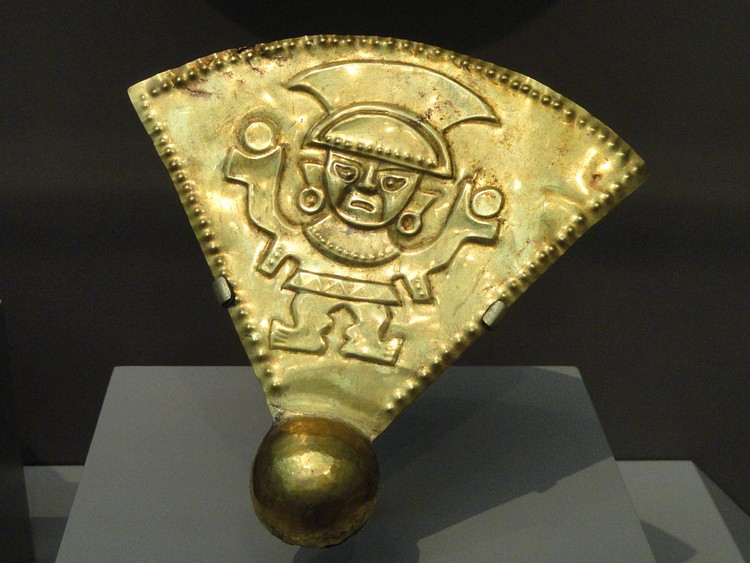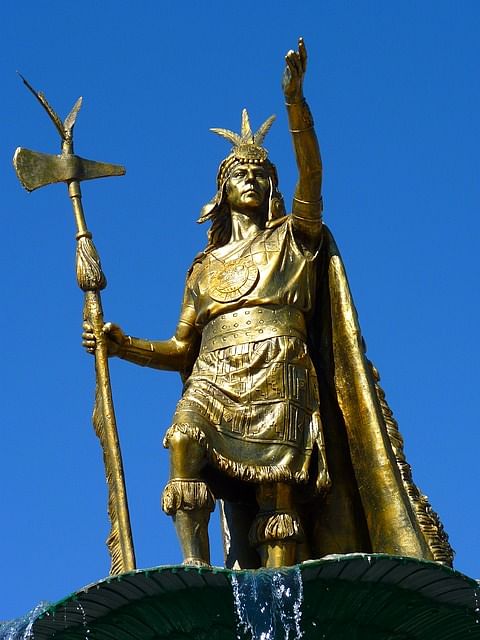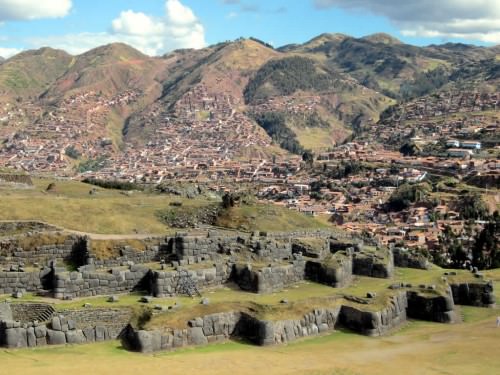Chimu Civilization › Pachacuti Inca Yupanqui » Ancient origins
Articles and Definitions › Contents
- Chimu Civilization › Ancient History
- Pachacuti Inca Yupanqui › Antique Origins
Ancient civilizations › Historical and archaeological sites
Chimu Civilization › Ancient History
Definition and Origins

The Chimú civilization, otherwise called the kingdom of Chimor, flourished on the northern coast of Peru between the 12th and 15th centuries CE. With their capital at Chan Chan the Chimu were the largest and most prosperous culture in the Late Intermediate Period and forged the second largest empire in the history of the ancient Andes. Their architecture, approach to regional governance, and art would also go on to influence their more famous successors, the Incas.
HISTORICAL OVERVIEW
The traditional founding ruler of the Chimú was Taycanamo who was considered to have been born from a golden egg and then arrived from the sea. Other notable rulers include Guacricaur, who expanded into the Moche, Santa, and Zaña valleys.Eventually the Chimú extended their territory even further south and in 1375 CE, under the rulership of Nancinpinco, conquered the Lambayeque (Sicán) culture absorbing some of their cultural practices and artistic ideas. The La Leche Valley was also brought under Chimú control so that, at its height during the reign of Minchançaman in c. 1400 CE, the area of Chimú influence stretched 1300 km along the coast of northern Peru.
CHAN CHAN WAS THE HUB OF A VAST TRADE AND TRIBUTE NETWORK AND NO FEWER THAN 26,000 CRAFTSMEN AND WOMEN RESIDED THERE.
The initial prosperity of the Chimú was largely due to their agricultural skills as they built an extensive irrigation system using canals. Later, their successful military campaigns and policy of extracting tribute ensured that they became the dominant regional power. Chan Chan came to be the capital of other administrative centres, such as at Farfán, Manchan, El Milagro, Quebrado Katuay, and the fortress site of Paramonga. This domination came to an end with the rise of the Incas who, led by Tupac Yupanqui, captured the 11th known Chimú ruler Minchançaman in c. 1470 CE. Thereafter, the Chimú became a vassal state in the Inca Empire, and their king was kept permanent prisoner at Cuzco to ensure compliance to the new order. The Incas also assimilated certain aspects of Chimú culture, such as rulers inheriting the title but not the property of their predecessors, the policy of allowing conquered rulers a certain autonomy, the idea to have compounds of foreign artists working for the state, and certain features of Chimú art. The Incas also kept written records of the Chimú culture and through these we have, albeit sparse, information regarding their rulers and principal gods. The latter include the creator god Ai Apaec, the sea god Ni, and, perhaps the most important deity in the Chimú pantheon, the moon goddess Si.

Chimu Textile
CHAN CHAN
The capital city of the Chimú was Chan Chan (known as Chimor to its original inhabitants) which, built at the mouth of the Rió Moche, covered some 20 square kilometres and had a population of up to 40,000 at its peak. The city became the hub of a vast trade and tribute network, and no fewer than 26,000 craftsmen and women resided there, often forcibly removed from conquered cities to mass produce high quality goods in a wide range of precious materials.
Chimú architecture is characterised by monumental adobe brick buildings. Ten royal palaces or compounds were constructed over the centuries in a rectangular layout, each with 10-metre high double exterior walls, labyrinthine interiors, and with only a single entrance. Of special note are the U-shaped audience rooms which controlled access to the store rooms. The walls of the compounds, built to restrict access by commoners, were decorated on the inside with bold relief designs, typically repeated geometric shapes, animals, and sea life, especially fish. The cut patterns may have been in imitation of those from textile wallhangings. Similar adobe compounds were built at other Chimú sites, for example, nine at Manchan and six at Farfán.
Functional structures within each compound include administrative and storage buildings and burial platforms accessed by ramps which contained mummified leaders. Over time the newer palaces became larger - the biggest covers an area of 220,000 square metres - and more space was dedicated to storage, indicative of the Chimú's policy of extracting tribute from conquered territories. Chan Chan also expanded in general with more residences for administrators and artisans, the latter living in modest dwellings of wattle-and-daub with steep roofs and a single hearth. The city also had an extensive irrigation system which combined canals, shallow reservoirs, and wells.

Chimu Spondylus Shell Necklace
CHIMÚ ART
Influenced by the Wari and Moche civilizations, the Chimú would continue and expand upon artistic themes which have become staple features of Andean art ever since. Chimú pottery is characterised by mould-made blackware and redware with sculpted decoration which is given a highly polished finish. The most common shape is double-spouted bulbous jars. Textiles have natural colours, the most precious with exotic feather decoration where plumes are sown in rows onto a cotton backing and dyed to create designs. Popular motifs include open-armed figures wearing headdresses - probably representing the ruling class - and double-headed 'rainbow' snakes. Textiles could also be decorated with precious metal additions and one tunic survives with 7,000 small gold squares individually sewn onto the fabric.
Carved and inlaid spondylus shells, acquired from Ecuador, were another popular medium for Chimú art with diamond-shape inlays creating striking jewellery pieces. Precious goods could also be made using gold, silver, and imported amber and emeralds from Colombia. Many examples of wooden sculptures have been recovered from two pyramid structures outside Chan Chan (Huaca el Dragón and Huaca Tacaynamo). Most such figures represent members of funerary processions.
Finally, it is interesting to note that Chimú rulers were themselves collectors of art from other cultures and their palaces were full of niches in which objects and statues were placed for display. Chan Chan artists themselves had such a reputation that the Incas forcibly relocated thousands of them, along with their finest pieces, to their capital at Cuzco which was also an effective method to control precious goods production and so limit the resources to fund rebellion.
Pachacuti Inca Yupanqui › Antique Origins
Definition and Origins

Pachacuti Inca Yupanqui (often simply Pachacuti or Pachacutec ) was the 9th Inca ruler (r. 1438 - 1471 CE) who founded their empire with conquests in the Cuzco Valley and beyond. Pachacuti is also credited with founding the site of Machu Picchu. His title Pachacuti, which he gave himself on his accession, means 'Reverser of the World' or 'Earth-shaker,' and the same word was used by the Incas to refer to the epoch-changing event or 'turning over of time and space' which they believed occurred regularly through history. An appropriate enough title, then, for a ruler who set his people on the road to prosperity and the creation of an empire which would eventually be the largest ever seen in the Americas.
RISE TO POWER
According to the semi-legendary early history of the Incas, Pachacuti rose to prominence when their war -like neighbours, the Chanca, attacked Cuzco in the early 15th century CE. The Inca ruler at the time, Viracocha Inca, and his son Inca Urco proved ineffectual in meeting this threat and fled the city. The young prince Pachacuti (known then as Cusi Yupanki) and a small band of loyal warriors, inspired by a vision of a shining tablet sent by the Sun god Inti, decided to stay and make a stand. Still, things looked desperate and Pachacuti called on the gods to help him more than sending messages of support.This they did by transforming rocks laying about the place into Inca warriors. With this army, Pachacuti kicked the Chanca out of Cuzco. In thanks for this divine help the leader set up the stone warriors ( Pururaucas ) in sacred shrines around the city.
BUILDING AN EMPIRE
Pachacuti was the first Inca ruler to have ambitions beyond Cuzco, and he conquered territories in the Cuzco (Huantanay) Valley and beyond, thus beginning the Inca empire which would grow and last until the Spanish conquest from 1532 CE. First, all speakers of the Inca language, Quechua, were given citizenship, a privileged status they would enjoy over all conquered peoples and which gave them the right to hold all important government and administrative offices.
PACHACUTI IS CREDITED WITH INTRODUCING THE VARIOUS APPARATUS OF STATE WHICH WOULD ENSURE THE INCAS COULD CONTINUE THEIR REGIONAL DOMINATION LONG-TERM.
Moving south-east Pachacuti then conquered the basin of Lake Titicaca, including the cultures of the Colla and Lupaqa.Pachacuti then retired to Cuzco while his brothers and son, Tupac Inca Yupanqui (with whom he may have co-ruled), were given the task of continuing the conquest of the Andes, perhaps making their first incursions south into Ecuador and the Chimu civilization. Concentrating on government Pachacuti is credited with introducing the various apparatus of state which would ensure the Incas could continue their regional domination long-term.
GOVERNMENT & CUZCO
The Inca ruler ( Sapa ) introduced systems of tribute and taxation which were paid by conquered peoples either in the form of goods or labour. These made the Incas unpopular but they were used productively to create an extensive road network linking towns and sacred sites. A system of storage houses ( qollqa ) were also built and dotted around the empire to ensure a plentiful food supply even in times of low agricultural yield. In an effort to simplify royal succession, Pachacuti instigated the system of a ruler nominating his principal wife from whom heirs to the throne would be drawn. Pachacuti had historians record the important episodes of Inca history on painted tablets, which were then stored for posterity in a building at the capital where no one without authorization might enter. Finally, he fixed the calendar of market days and public holidays.

Sacsahuaman
With his conquests and income made more secure, Pachacuti, perhaps following an inspirational visit to monumental Tiwanaku, then set about aggrandising his capital and replacing its many earthen structures with impressively crafted stonework. He drained the northern area of Cuzco and built there a new ceremonial centre and built himself a palace known as Kunturkancha. He also rebuilt the Temple of Inti in the Coricancha complex and started construction of the fortress-like Sacsayhuaman which would protect the northern approach to Cuzco. Pachacuti built city-temple-fortress sites at other strategically important locations such as Pisac and Ollantaytambo at either end of the Urubamba Valley and many way-stations in the outposts of the empire such as Tambo Colorado on the coast.
MACHU PICCHU
Pachacuti Inca Yupanqui probably founded Machu Picchu (meaning 'old hill') c. 1450 CE. The purpose of the site is not agreed upon by scholars and may have been a fortress, imperial retreat, a symbol of Inca power for the benefit of conquered locals, or a ceremonial precinct. Perhaps the most likely role was the latter as most of the architecture was designed for religious purposes, and the site's fortifications may well have been put in place to ensure only a select few could enter this sacred site.In further support of this interpretation, a road was discovered which linked the site to several residential settlements dotted along the valley. The town had capacity for around 1,000 residents at its peak and ranked amongst the most sacred of all sites for the Inca. On the ruler's death the ownership of the site passed to Pachacuti's family successors. The site was abandoned by the Inca shortly before Pizarro and the Spanish conquistadors arrived in South America, who never stumbled across it.

Machu Picchu
DEATH & BURIAL
The Inca ruler died in 1471 CE and, according to his wishes, the Incas mourned for one whole year. They then held a month-long celebration of their great leader during which his personal items were paraded around the corners of the empire, a mock battle was staged at Cuzco, and 2,000 llamas were sacrificed. A thousand more llamas were sacrificed around the empire and, so too, children were sacrificed in all the places that the ruler had visited in his lifetime.
Pachacuti was mummified and may have been buried in a shrine known as Patallacta at Kenko (Q'enqo') on the heights above Cuzco. Even after death, the ruler continued to be venerated and his mummy ( mallki ), along with other past rulers, was regularly given outings into the outside world where it was ritually fed and even, on occasion, 'consulted' in times of political strife. In addition, the Inca's hair and fingernails were incorporated into a sacred statue of him, and Pachacuti's large stone hunting lodge at Tambo Machay, just above Cuzco, was made into a sacred site or huaca. In the official Inca state archives, such were his stature and achievements, that almost all significant developments in statecraft and empire were credited to Pachacuti.
Tupac Inca Yupanqui took over as Sapa Inca and continued his father's imperial plans, eventually doubling the size of the empire. In 1559 CE the Spanish discovered Pachacuti's mummy, which had been secretly hidden by the Incas following the conquest. It was sent to Lima by Juan Polo de Ondegardo but was lost in transit or perhaps simply destroyed like so many other symbols of Inca culture.
LICENSE:
Article based on information obtained from these sources:with permission from the Website Ancient History Encyclopedia
Content is available under License Creative Commons: Attribution-NonCommercial-ShareAlike 3.0 Unported. CC-BY-NC-SA License